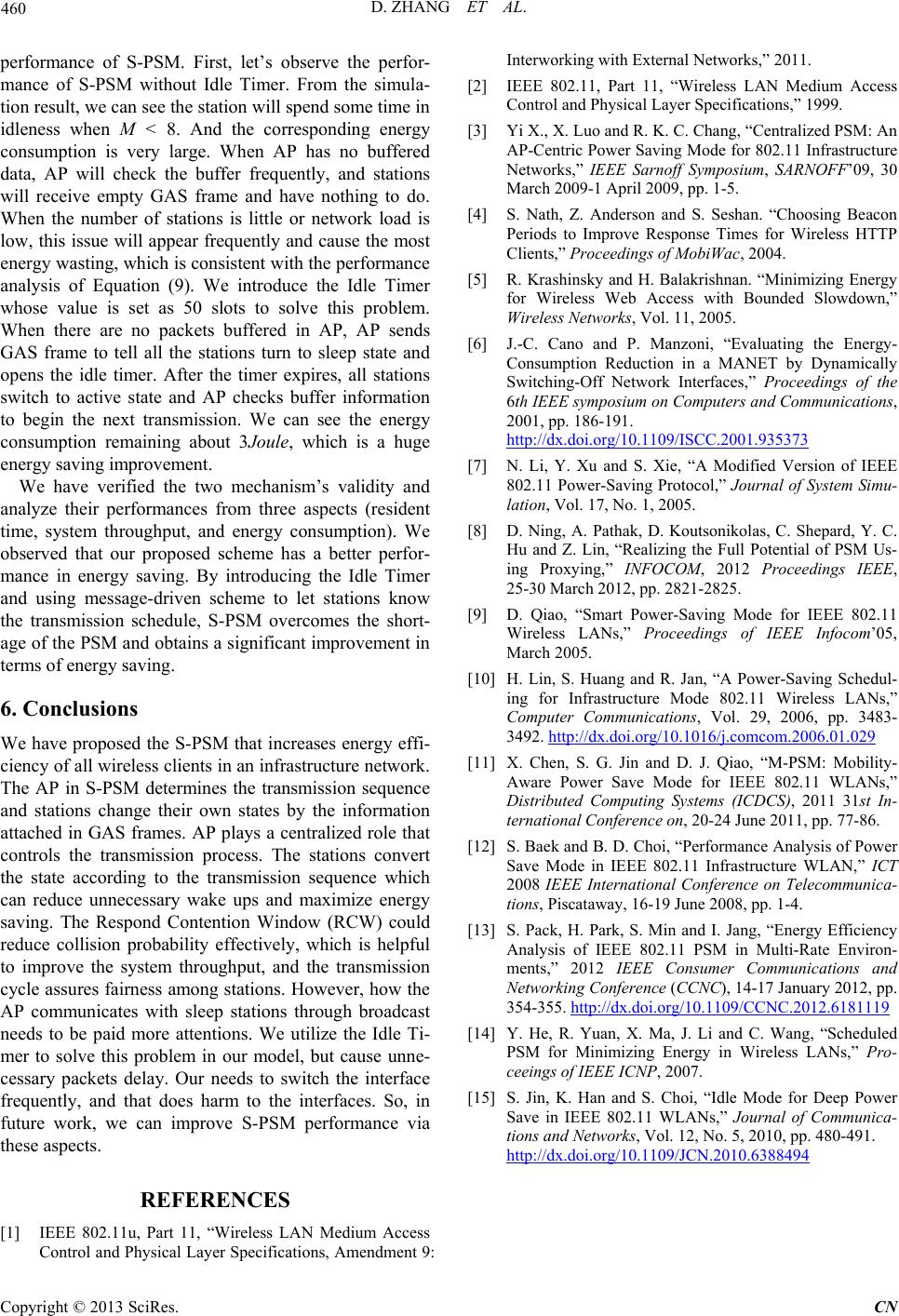
D. ZHANG ET AL.
Copyright © 2013 SciRes. CN
performance of S-PSM. First, let’s observe the perfor-
mance of S-PSM without Idle Timer. From the simula-
tion result, we can see the station will spend some time in
idleness when M < 8. And the corresponding energy
consumption is very large. When AP has no buffered
data, AP will check the buffer frequently, and stations
will receive empty GAS frame and have nothing to do.
When the number of stations is little or network load is
low, this issue will appear frequently and cause the most
energy wasting, which is consistent with the performance
analysis of Equation (9). We introduce the Idle Timer
whose value is set as 50 slots to solve this problem.
When there are no packets buffered in AP, AP sends
GAS frame to tell all the stations turn to sleep state and
opens the idle timer. After the timer expires, all stations
switch to active state and AP checks buffer information
to begin the next transmission. We can see the energy
consumption remaining about 3Joule, which is a huge
energy saving improvement.
We have verified the two mechanism’s validity and
analyze their performances from three aspects (resident
time, system throughput, and energy consumption). We
observed that our proposed scheme has a better perfor-
mance in energy saving. By introducing the Idle Timer
and using message-driven scheme to let stations know
the transmission schedule, S-PSM overcomes the short-
age of the PSM and obtains a significant improvement in
terms of energy saving.
6. Conclusions
We have proposed the S-PSM that increases energy effi-
ciency of all wireless clients in an infrastructure network.
The AP in S-PSM determines the transmission sequence
and stations change their own states by the information
attached in GAS frames. AP plays a centralized role that
controls the transmission process. The stations convert
the state according to the transmission sequence which
can reduce unnecessary wake ups and maximize energy
saving. The Respond Contention Window (RCW) could
reduce collision probability effectively, which is helpful
to improve the system throughput, and the transmission
cycle assures fairness among stations. However, how the
AP communicates with sleep stations through broadcast
needs to be paid more attentions. We utilize the Idle Ti-
mer to solve this problem in our model, but cause unne-
cessary packets delay. Our needs to switch the interface
frequently, and that does harm to the interfaces. So, in
future work, we can improve S-PSM performance via
these aspects.
REFERENCES
[1] IEEE 802.11u, Part 11, “Wireless LAN Medium Access
Control and Physical Layer Specifications, Amendment 9:
Interworking with External Networks,” 2011.
[2] IEEE 802.11, Part 11, “Wireless LAN Medium Access
Control and Physical Layer Specifications,” 1999.
[3] Yi X., X. Luo and R. K. C. Chang, “Centralized PSM: An
AP-Centric Power Saving Mode for 802.11 Infrastructure
Networks,” IEEE Sarnoff Symposium, SARNOFF’09, 30
March 2009-1 April 2009, pp. 1-5.
[4] S. Nath, Z. Anderson and S. Seshan. “Choosing Beacon
Periods to Improve Response Times for Wireless HTTP
Clients,” Proceedings of MobiWac, 2004.
[5] R. Krashinsky and H. Balakrishnan. “Minimizing Energy
for Wireless Web Access with Bounded Slowdown,”
Wireless Networks, Vol. 11, 2005.
[6] J.-C. Cano and P. Manzoni, “Evaluating the Energy-
Consumption Reduction in a MANET by Dynamically
Switching-Off Network Interfaces,” Proceedings of the
6th IEEE symposium on Computers and Communications,
2001, pp. 186-191.
http://dx.doi.org/10.1109/ISCC.2001.935373
[7] N. Li, Y. Xu and S. Xie, “A Modified Version of IEEE
802.11 Power-Saving Protocol,” Journal of System Simu-
lation, Vol. 17, No. 1, 2005.
[8] D. Ning, A. Pathak, D. Koutsonikolas, C. Shepard, Y. C.
Hu and Z. Lin, “Realizing the Full Potential of PSM Us-
ing Proxying,” INFOCOM, 2012 Proceedings IEEE,
25-30 March 2012, pp. 2821-2825.
[9] D. Qiao, “Smart Power-Saving Mode for IEEE 802.11
Wireless LANs,” Proceedings of IEEE Infocom’05,
March 2005.
[10] H. Lin, S. Huang and R. Jan, “A Power-Saving Schedul-
ing for Infrastructure Mode 802.11 Wireless LANs,”
Computer Communications, Vol. 29, 2006, pp. 3483-
3492. http://dx.doi.org/10.1016/j.comcom.2006.01.029
[11] X. Chen, S. G. Jin and D. J. Qiao, “M-PSM: Mobility-
Aware Power Save Mode for IEEE 802.11 WLANs,”
Distributed Computing Systems (ICDCS), 2011 31st In-
ternational Conference on, 20-24 June 2011, pp. 77-86.
[12] S. Baek and B. D. Choi, “Performance Analysis of Power
Save Mode in IEEE 802.11 Infrastructure WLAN,” ICT
2008 IEEE International Conference on Telecommunica-
tions, Piscat away, 16-19 June 2008, pp. 1-4.
[13] S. Pack, H. Park, S. Min and I. Jang, “Energy Efficiency
Analysis of IEEE 802.11 PSM in Multi-Rate Environ-
ments,” 2012 IEEE Consumer Communications and
Networking Conference (CCNC), 14-17 Jan uary 2012, pp.
354-355. http://dx.doi.org/10.1109/CCNC.2012.6181119
[14] Y. He, R. Yuan, X. Ma, J. Li and C. Wang, “Scheduled
PSM for Minimizing Energy in Wireless LANs,” Pro-
ceeings of IEEE ICNP, 2007.
[15] S. Jin, K. Han and S. Choi, “Idle Mode for Deep Power
Save in IEEE 802.11 WLANs,” Journal of Communica-
tions and Networks, Vol. 12, No. 5, 2010, pp. 480-491.
http://dx.doi.org/10.1109/JCN.2010.6388494